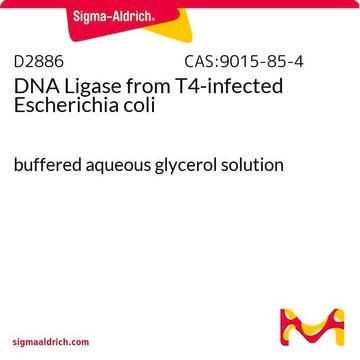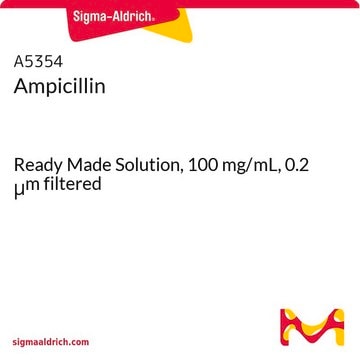LIG2
QuickLink™ DNA Ligation Kit
joins blunt-end and sticky-end DNA fragments
Sinônimo(s):
DNA Ligation Kit, Ligation Kit
About This Item
Produtos recomendados
grau
for molecular biology
Nível de qualidade
forma
liquid
uso
kit sufficient for 50 ligation reactions
técnica(s)
molecular cloning: suitable
Condições de expedição
dry ice
temperatura de armazenamento
−70°C
Descrição geral
Aplicação
- Joining blunt or cohesive-end fragments of DNA into a cloning vector
- Recircularization of linear DNA
- Formation of concatamers
- dsDNA nick repair
Características e benefícios
- Fast 5 minutes ligation
- High ligation efficiency
- Room temperature reactions – no cooling required
- Perform bacterial transformation with the reaction mixture
Componentes
- 500uL 2X Ligation Buffer A (L9537)
- 100uL 5X Ligation Buffer B (L9662)
- 250 units T4 DNA Ligase (D2886) in 50% glycerol with 10 mM Tris-HCl (pH 7.5) 50 mM KCl, and 1 mM DTT
Princípio
Informações legais
produto relacionado
Código de classe de armazenamento
10 - Combustible liquids
Ponto de fulgor (°F)
Not applicable
Ponto de fulgor (°C)
Not applicable
Certificados de análise (COA)
Busque Certificados de análise (COA) digitando o Número do Lote do produto. Os números de lote e remessa podem ser encontrados no rótulo de um produto após a palavra “Lot” ou “Batch”.
Já possui este produto?
Encontre a documentação dos produtos que você adquiriu recentemente na biblioteca de documentos.
Protocolos
T4 DNA ligase is used for the joining of DNA molecules with compatible cohesive (sticky) termini, joining of blunt ended double stranded DNA molecules
Nossa equipe de cientistas tem experiência em todas as áreas de pesquisa, incluindo Life Sciences, ciência de materiais, síntese química, cromatografia, química analítica e muitas outras.
Entre em contato com a assistência técnica








